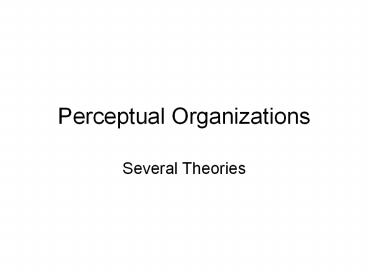Perceptual Organizations - PowerPoint PPT Presentation
1 / 11
Title:
Perceptual Organizations
Description:
Perceptual Organizations Several Theories Constructionist View The brain constructs a perception out of a great many individual sensations. For example: When you meet ... – PowerPoint PPT presentation
Number of Views:151
Avg rating:3.0/5.0
Title: Perceptual Organizations
1
Perceptual Organizations
- Several Theories
2
Constructionist View
- The brain constructs a perception out of a great
many individual sensations. - For example When you meet someone, you look at
their face and your brain takes in sensations
from each part of their face creating how you see
the face.
3
The Gestalt Psychologists
- Max Wertheimer
- Germen Psychologist
- Formed a group of psychologists that believed
that the whole is more important the sum of the
parts and that each part affects every other. - The brain immediately perceives a stimulus as a
whole, rather than focusing on the individual
sensations.
4
More on the Gestalt School
- Focused on interactions of the parts observing
how the brain uses certain perceptual cues to
make sense of the things. - Developed laws of perception.
- There are four Gestalt Laws of perception.
5
Law of Proximity
- We tend to group together things that are
- close to one another.
- See page 69
6
Law of Similarity
- We group together things that have some
- visual element in common, such as size,
- shape and color.
- See Page 69
7
Law of Contiuation
- We tend to see interrupted lines as
- continuous lines with something hiding part
- of them.
- See page 70
8
Law of Closure
- We tend to fill in missing details to complete
- a figure so that it has a consistent overall
- Form.
- See page 70
9
Cant see the forest for the trees
- Bottom up processing Pattern recognition that
begins with an analysis of small units or
features and eventually results in perception. - Top Down Processing Involves a persons
knowledge of the world. Begins with an analysis
of higher-level information that you already may
have about the stimulus.
10
Are you a top down or bottom up thinker?
- Do you concentrate on details of a situation and
make up your mind or do you include prior
knowledge and look at the big picture? - Details Bottom up
- Big Picture Top Down
11
(No Transcript)

